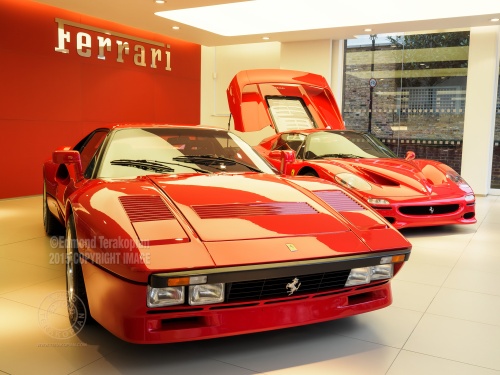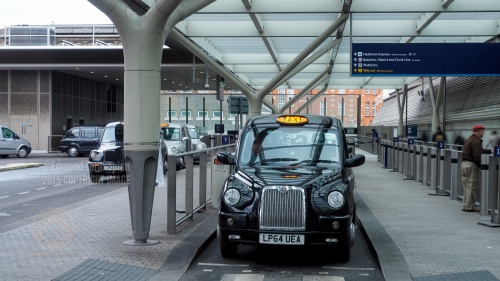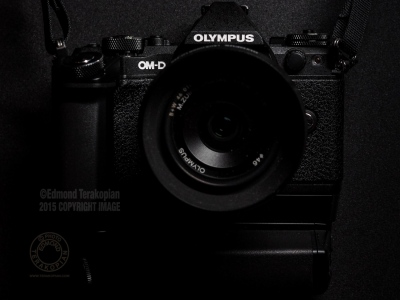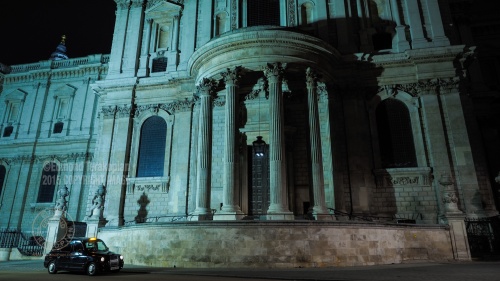Is The Sequel Any Good?!
Cameras come and cameras go. It’s a cycle that every manufacturer repeats every few years. As a professional photographer, I naturally keep my eyes open for new and better tools and as a reviewer of camera equipment for my blog and also various magazines over the years, I naturally get to use and review a lot of equipment from a lot of the main brands in our industry.

The new Olympus OM-D E-M5 Mark II fitted with the HLD-8 Power Battery Grip. February 05, 2015. Photo: © Edmond Terakopian
So, how do I know if a camera is any good? Well, one sure way is at the end of the test, when I box away the camera to send back. If at this stage I feel bad and want to hold on to the camera, that gut feeling says it all. As I boxed away the OM-D E-M5 Mark II last night and begun taping up the box, I really wished I could keep it!

The new Olympus OM-D E-M5 Mark II. The two grips, the HLD-8 Power Battery Grip. February 05, 2015. Photo: © Edmond Terakopian
Although I never used Olympus in the days of film, I always really fancied the OM3Ti; to the point that even now, once in a while I’ll look them up on eBay! When Olympus launched the first PEN, the E-P1, my interest in the company’s cameras was re-invigorated. Since, I’ve owned and use various PEN cameras, the most recent being the brilliant E-P5. When I saw the first OM-D, the E-M5, I did rather like it and when I saw the E-M1, I did rather love it. It was a camera that just felt perfect from the second I picked it up and since has become my most used camera system, putting my Canon DSLR and Leica M setups in early and part time retirement. I’ve been using the new E-M5 Mark II for exactly two weeks now. My first outing with it was a video shoot of an anti ivory demonstration at the Chinese Embassy, which will be used in the feature length documentary, The Last Animals. Having played with the camera the evening before, it gave me such confidence in it’s abilities that I was happy to take it on a real and important assignment the next day. Although I brought a Canon 5D MkIII as a backup, just in case, the little Olympus worked faultlessly and perfectly, allowing me to shoot the entire demo with it. The camera’s ergonomics and menu system are very well designed. Not having a manual for the two weeks meant having to figure everything out by exploration and I’m happy to say that everything just came together nicely, all because of a well thought out camera, by designers and engineers who clearly understand photography and photographers.

A rare Ferrari 288 GTO built in 1985 with only 883 miles on the clock. It is valued at £2,000,000 and available from H.R. Owen in South Kensington, London. Image shot on the Olympus OM-D E-M5 II, using the multi shot sensor shift facility, creating a 40 megapixel image. January 30, 2015. Photo: ©Edmond Terakopian
One of the highlight aspects of the E-M5 Mark II is it’s new high resolution mode; the resolution is boosted from it’s normal 16mp to a whopping 40mp. It does this by taking eight images, shifting the sensor for each shot and combining them into a 40mp jpeg, all in a matter of seconds. As the camera can fire up to 11 shots in the silent continuous mode (more of this later), the actual picture can be taken in under or around a second, so long exposure’s aren’t needed.

A rare Ferrari 288 GTO built in 1985 with only 883 miles on the clock. It is valued at £2,000,000 and available from H.R. Owen in South Kensington, London. Image shot on the Olympus OM-D E-M5 II, using the multi shot sensor shift facility, creating a 40 megapixel image. January 30, 2015. Photo: ©Edmond Terakopian

A detail crop; A rare Ferrari 288 GTO built in 1985 with only 883 miles on the clock. It is valued at £2,000,000 and available from H.R. Owen in South Kensington, London. Image shot on the Olympus OM-D E-M5 II, using the multi shot sensor shift facility, creating a 40 megapixel image. January 30, 2015. Photo: ©Edmond Terakopian
The processing of the eight images then takes a couple of seconds. A tripod is a must and your subject needs to be still, but I can see a lot of creative uses of this with moving subjects! The results are astonishing though. An image dimension of 7296 x 5472 takes things into the higher end of medium format territory. The results are pin sharp, full of detail and tonal range. Whilst this wasn’t a feature I was enamoured by when I first found out about it, having used it, it has really blown my mind!

Taxi Rank, Paddington Station, London. Image shot on the Olympus OM-D E-M5 II, using the multi shot sensor shift facility, creating a 40 megapixel image. February 01, 2015. Photo: Edmond Terakopian
To download a full resolution file of the above image and see for yourself, follow THIS LINK. The other huge feature of the E-M5 Mark II is an updated and even more capable 5-axis in camera stabiliser. In a nutshell, every axis of movement is stabilised, meaning hand held shot are possible at very slow shutter speeds for pin sharp photographs. With practice I found I can shoot hand held at down to almost a one second exposure.
Shooting Video
This stabiliser also works in the video mode and in this aspect, pushes the camera to be one of the most able video shooting stills cameras around. It frees the user up to shooting so much more hand held shots. In my short film Taxi Driver, I shot the majority of shots completely hand held. Something I would never do with a DSLR, even with a stabilised lens.
Some of the shots in the film were done by attaching the camera and a mic, onto the windscreen of the taxi or to the bonnet, using a Delkin Fat Ghecko vehicle mount. This triple suction mount worked perfectly, but on it’s own offers no means of stabilisation. Considering how much a diesel London Taxi vibrates and the state of the bumpy roads in some parts of town, the smooth results just blew me away. The stabiliser is both extremely capable and extremely freeing, allowing you to shoot and create, without worrying about steadycams or a tripod. In fact, the only scenes I used a tripod and monopod were for the interview in the cafe and a few shots of a taxi rank. The rest of the seven hour shoot was freehand! By adding a grip (either the HLD-8 or HLD-8 Power Battery Grip) one also adds a headphone socket. This is essential for being able to monitor what the microphone is picking up and really makes this camera an even better video shooter. Thankfully, the audio gain level (along with ISO, aperture, shutter speed and headphone volume) can be changed using the silent touch screen during video shooting. Brilliant!

The new Olympus OM-D E-M5 Mark II. Picture shows the all important headphone socket, now part of the optional (and essential) grip, the HLD-8G and HLD8 Battery Power Grip (shown), February 05, 2015. Photo: © Edmond Terakopian
Thankfully, we now have variable frame rates, meaning that 60p, 50p, 30p, 25p and 24p can be used for full 1080p HD video. The video file itself is very beefy! ALL‑I has a data rate of 77Mbps. IPB gives the following data rates in the following quality setting: SF: ~52Mbps, F: ~30Mbps, N: ~18Mbps. Having shot the majority of the two films in ALL-I at 77Mbps, I can say that the detail holds up extremely well, rendering both highlight and shadow detail properly, allowing for proper grading. It also pushes the camera’s data rate into one the BBC with their stringent guidelines should approve of. Another very handy feature is various levels of slow motion (and speeded up footage) available in camera. I have made good use of the slow motion and am very pleased with the results. You can see this in action in my London Taxi film mentioned earlier.

The new Olympus OM-D E-M5 Mark II fitted with the HLD-8 Power Battery Grip and Rode Steroe VideoMic X. February 05, 2015. Photo: © Edmond Terakopian
On the audio front, the camera has the all important audio limiter, meaning loud sounds or a raise in volume won’t blow the audio and make it useless. The audio is also recorded at 16 bit, 48Hz, Wave Format Base, meaning it’s actually of better than CD quality and not compressed. Naturally there is an on screen audio meter during shooting. Although the camera has built in stereo microphones, it also comes with the essential mic socket, and during filming my Rode VideoMic Pro and Rode Stereo VideoMic X found themselves at home and recording great audio. Other Goodies The flip out, articulated screen is a great bonus which allows various camera angles to be used with ease. One thing I found I was going a lot was flipping it so the screen was hidden from view and the camera resembled a film camera. This is great as it’ll stop the chimping photographer, make them concentrate on the scene and not the camera back and as a result save on battery power. During the interview scene in London Taxi, I was shooting multicam, and the screen allowed me to tilt it on the wide camera, meaning I could keep an eye on it and on the one in my hand; very handy indeed. Another very handy aspect for me was the practically silent shutter. It can barely be heard and on the street, it should be completely inaudible. Need to take pictures in a monastery of monks who have taken a vows of silence? Not a problem as there is also a completely silent electronic shutter mode. And yes, I do mean silent. Completely. Zero sound. It’s absolutely astonishing to put the camera into silent continuous and know one’s shooting 11 frames per second, in absolute, total and complete silence! In normal mode, the barely audible shutter mode means in continuous mode, the count drops by a frame to 10fps.
The built in WiFi remains from the previous cameras and married to the Olympus O.I. Share app on iOS means you can download jpegs (I always shoot RAW and medium jpeg for just this reason) and also have full, wireless remote camera control. This naturally opens up huge possibilities and also allows quick sharing of images on social media (just check out my Instagram!) or for sending a quick image to a client for approval or a newspaper for publication. As a very important bonus, the battery system is the same as the previous OM-Ds and PENs; this means that when travelling, one needs one type of charger and one set of batteries. It’s this type of uniformity that endears a brand to the photographer and really helps on assignment. Final Thoughts So, is everything perfect? So far, I have had nothing but praise for this camera; I almost have nothing but praise for this camera. The only thing that bugs me, is the rear function button, labelled Fn1. It’s just too small and flat and is next to a lever which juts out too much, adding to it’s difficult use. In normal function button use, this isn’t an issue and works perfectly well when holding the camera away from the face and accessing the menus, but there are some photographers, myself included, who prefer back button focus, so assign all AF use to the back button. Whilst it’s usable, it’s not comfortable and not as tactile as it should be. So if you’re one of the breed who likes to back button focus, you will be annoyed. However, I like this camera so much that I will try and find a way to attach something to this button to make it stand out a few millimetres.
Well, as I mentioned at the beginning, I don’t want to return this test camera back to Olympus; I like it that much. One thing is for sure, a couple of E-M5 Mark II cameras will definitely be joining my bag as soon as they are available. My E-M1 cameras are extremely capable (and will be even better with the new firmware bring faster continuous AF, I’m sure) but for video, the E-M5 Mark II has raised the bar tremendously. For me, it’s a must have camera…..so yes, the sequel is much better! Links: Here’s my Flickr Album with E-M5 MarkII images; this will be updated, so do keep an eye on it.
Addendum

My black Olympus OM-D E-M5 Mark II camera and M.Zuiko 17mm f1.8 lens. April 29, 2015. Photo: Edmond Terakopian
A few months on and I’ve got myself a pair of E-M5 Mark II cameras. As I’ve already mentioned, it’s a great camera. In fact, I have an assignment tomorrow and I’ll only be shooting on these; shall leave the E-M1 cameras at home. One thing however has changed since my review; the back “Function 1” button. Olympus have clearly been listening to the feedback and seem to have completely changed the button’s mechanics. It’s no longer hard to press and feels much better. The design isn’t ideal as the lever juts out too much, but with the button being softer to the touch and with much more feel, back button focusing is actually achievable comfortably. I’ve set up both my cameras with back button focus enabled. Top marks to Olympus for making this small yet significant change since the sample camera I had for my initial review.













Thanks for the review. Quick typo you might want to correct though… The first Olympus (digital) PEN was the E-P1, not the E-M1 as you’ve written.
Oops! Thanks 🙂
Pingback: Olympus OM-D E-M5 Mark II Launch | Photo This & That
I thank you very much for this ( great) review. So far I am only interested in the video section of this kind of Camera. Though I always used Canon or Nikon for photo shooting I always like Olympus camera. But at that time (I mean the time you focused manually) Olympus never produced high speed synchronization speed for flash, 1/250).
Now, I own a GH3 Panasonic for video shooting. To me, this camera lacks mainly stabilization and focus peaking but the overall quality is great.
I understood that you liked the video quality of this Olympus camera and I spent several hours looking video films on the internet trying to see how good, or bad, is this Olympus with video.
I am not sure the video quality of the Olympus reach the one of the GH3 and something is disturbing me. The colors look sometimes strange. At the beginning of your film the faces of people in the streets are yellow/green!! and then all colors turn to red. During the interview of the taxi driver, I could notice your were using two cameras, great, that the sharpness of the image is good also but the color? look reddish? Where you in trouble with the colors? Thank you for your comment because I really think in changing my GH3 for the Olympus camera because I really need stability, I do some filming on sailing boats ans stability is really crucial to me.
The colours the camera produces are absolutely spot on perfect. I’ve graded the film with Reg Giant’s Looks and this has given it a look and colouring, so this is not accurate colour, it’s more stylised. Have a look at my other short, Prague Pursuit which whilst graded, is a more gentle and subtle grade using Film Convert: https://vimeo.com/119294831 I can’t recommend this camera highly enough; the stabiliser and quality of file are superb, and by the sounds of it, will be perfect for your needs.
Thank you so much for your quick answer and your advice Edmond.
Thanks a lost for your review. Here’s a tip to get raid of this back button focus problem: use Sugru to reshape the button. I use this on my E-M5 Mk I and it works very well.
Thanks for the tip; it’s been suggested by a few now, so when I do get my own Mark II, no doubt I shall get some Sugru too 🙂
Did not know this product !